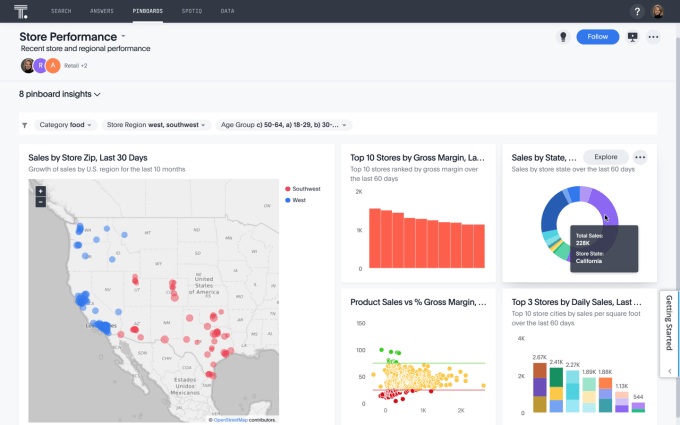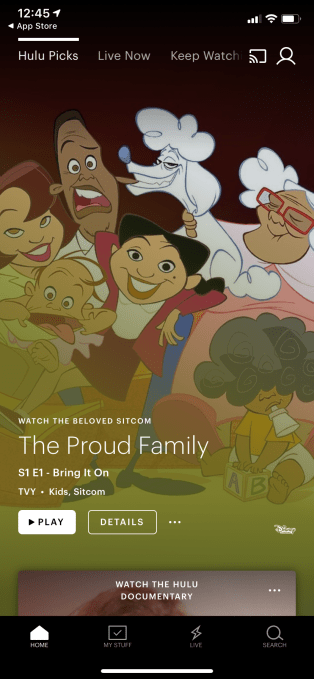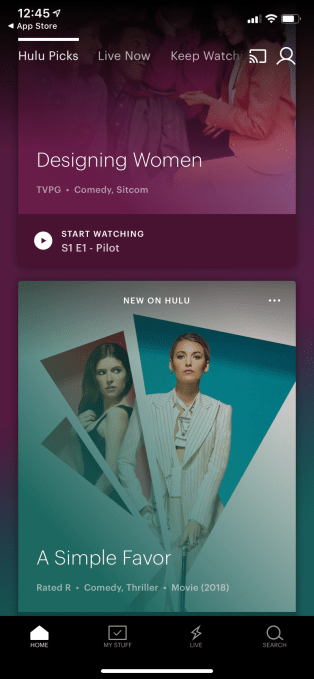Insta360’s tiny new GO stabilized camera could be game-changer for social video
Insta360 has quickly established itself as the leader in 360-degree video capture, at least for the consumer market, and its new GO stabilized camera builds on that legacy and extends some of the tech it has built into the category of more traditional, non-360-degree footage.
The $199.99 GO is truly tiny — it weighs less than an ounce and measures less than two inches tall and an inch wide. It’s tiny, and that’s ideal for the use case that Insta360 has in mind for this device — wearing it or mounting it virtually anywhere for capturing quick clips. The GO’s all about quick action grabs, with a 30-second cap on clip recording, which you trigger by pressing the lone control button on the device (a second press stops the clip, unless you let it run the entire 30 seconds).
GO’s design is clearly meant for social sharing, but its secret weapon — versus just using your smartphone or making use of other devices — is that it packs Insta360’s FlowState stabilization on board. This is the company’s digital video stabilization feature, which works to great effect in its Insta360 One X 360-degree camera for smoothing out footage so that even in intense action sequences it’s not nausea-inducing.
GO also features a magnetic body, which is designed to work in tandem with a variety of accessories, including backs for securing them unobtrusively to clothing, an underwater housing (the camera itself is IPX4 rated, which means essentially it’s protected from splashes but not meant to be submerged) and mounts for sticking to things like surf boards or vehicles. It can capture clips at a resolution of up to 2720 x 2720, but it crops the image to 1080p (at 25 fps) for export as a result of the stabilization tech.
Shooting modes include a standard 25 fps as mentioned, as well as a 30 fps time-lapse, which can record up to eight hours (which will output a 9-second video) and a hyperlapse mode that can shoot for up to 30 minutes to generate a five-minute video. It can capture photos, too, exporting square images at 2560 x 2560 resolution, or a number of landscape options reading down from there.
In addition to simplifying capture, the Insta360 GO also hopes to make editing and sharing much easier with its FlashCut auto-editing feature. This software tool uses “AI” according to the company, in order to find the best clips (you can even sort by category, i.e. “food”) you capture throughout the day and then stitch them together in a final edit. You also can fully tweak the edits it provides if you’d rather be a more involved creator.
The biggest limitation, based on just reading the specs and not having had a chance to test this out yet, is that the battery life is rated at around 200 clips per day, based on an average of 20 seconds per clip. But that’s including recharging the camera when not in use using the included Charge Case, which has 2.5 extra charges using its built-in battery. That and the recording limitation could prove challenging to anyone looking to create a lot of content with this camera, but on the other hand, it’s very easy to ensure you have it with you at all times — even when your smartphone isn’t nearby. At $199.99, the Insta360 GO isn’t exactly cheap — but it does include the Charge Case, a pendant with a magnet you can use to wear it around you neck, a stand, a clip for clothing and a sticky mount for putting it on most smooth surfaces. You also can laser-engrave it if you purchase it directly via Insta360’s website. But after some missed starts for this category, like the Google Clips camera, and earlier entrants like, the Memoto and Narrative Clip life-logging cameras, I’ll be curious to see if Insta360’s additional features help this gadget define a category.
At $199.99, the Insta360 GO isn’t exactly cheap — but it does include the Charge Case, a pendant with a magnet you can use to wear it around you neck, a stand, a clip for clothing and a sticky mount for putting it on most smooth surfaces. You also can laser-engrave it if you purchase it directly via Insta360’s website. But after some missed starts for this category, like the Google Clips camera, and earlier entrants like, the Memoto and Narrative Clip life-logging cameras, I’ll be curious to see if Insta360’s additional features help this gadget define a category.
Powered by WPeMatico
ThoughtSpot hauls in $248M Series E on $1.95B valuation
ThoughtSpot was started by a bunch of ex-Googlers looking to bring the power of search to data. Seven years later the company is growing fast, sporting a fat valuation of almost $2 billion and looking ahead to a possible IPO. Today it announced a hefty $248 million Series E round as it continues on its journey.
Investors include Silver Lake Waterman, Silver Lake’s late-stage growth capital fund, along with existing investors Lightspeed Venture Partners, Sapphire Ventures and Geodesic Capital. Today’s funding brings the total raised to $554 million, according to the company.
The company wants to help customers bring speed to data analysis by answering natural language questions about the data without having to understand how to formulate a SQL query. As a person enters questions, ThoughtSpot translates that question into SQL, then displays a chart with data related to the question, all almost instantly (at least in the demo).
It doesn’t stop there though. It also uses artificial intelligence to understand intent to help come up the exact correct answer. ThoughtSpot CEO Sudheesh Nair says that this artificial intelligence underpinning is key to the product. As he explained, if you are looking for the answer to a specific question, like “What is the profit margin of red shoes in Portland?,” there won’t be multiple answers. There is only one answer, and that’s where artificial intelligence really comes into play.
“The bar on delivering that kind of answer is very high and because of that, understanding intent is critical. We use AI for that. You could ask, ‘How did we do with red shoes in Portland?’ I could ask, ‘What is the profit margin of red shoes in Portland?’ The system needs to know that we both are asking the same question. So there’s a lot of AI that goes behind it to understand the intent,” Nair explained.

Image: ThoughtSpot
ThoughtSpot gets answers to queries by connecting to a variety of internal systems, like HR, CRM and ERP, and uses all of this data to answer the question, as best it can. So far, it appears to be working. The company has almost 250 large-company customers, and is on a run rate of close to $100 million.
Nair said the company didn’t necessarily need the money, with $100 million still in the bank, but he saw an opportunity, and he seized it. He says the money gives him a great deal of flexibility moving forward, including the possibility of acquiring companies to fill in missing pieces or to expand the platform’s capabilities. It also will allow him to accelerate growth. Plus, he sees the capital markets possibly tightening next year and he wanted to strike while the opportunity was in front of him.
Nair definitely sees the company going public at some point. “With these kind of resources behind us, it actually opens up an opportunity for us to do any sort of IPO that we want. I do think that a company like this will benefit from going public because Global 2000 kind of customers, where we have our most of our business, appreciate the transparency and the stability represented by public companies,” he said.
He added, “And with $350 million in the bank, it’s totally [possible to] IPO, which means that a year and a half from now if we are ready to take the company public, we can actually have all options open, including a direct listing, potentially. I’m not saying we will do that, but I’m saying that with this kind of funding behind us, we have all those options open.”
Powered by WPeMatico
Ready, Set, Raise — the Y Combinator for female founders — announces second cohort
About one-fourth of the startups in Y Combinator’s summer batch had a female founder. Not the most disappointing statistic if you consider this: Companies with at least one female founder have raised only about 11% of venture capital funding in the U.S. in 2019, according to PitchBook. Companies with female founders exclusively have raised just 3%.
There is so much room for improvement.
To close the funding gap, programs tailored to female entrepreneurs are working tirelessly to mentor and incubate upstarts in hopes of impressing venture capitalists. Ready, Set, Raise, an accelerator program built for women, by women, is amongst the new efforts to help female and non-binary founders raise more dollars, or, at the very least, build relationships with investors.
The accelerator program, created by the Seattle-based network of startup founders and investors called the Female Founders Alliance, is today announcing its second batch of companies, a group that includes a sextech business, an AI-powered tool for podcasters and a line of workwear created for women who work on farms, construction sites and factory floors.
Ready, Set, Raise has partnered with Microsoft for Startups to provide entrepreneurs $120,000 in Azure credits, as well as technical and business mentoring from executives of the Redmond-based software giant. Other new partners include Brex and Carta, two well-funded companies that plan to lend the support of their executives to teach entrepreneurs about startup finance, valuation and fundraising terms.
“Both FFA and Microsoft recognize a major lapse in opportunities given to women and non-binary founders,” writes Ian Bergman, a managing director of Microsoft for Startups, in a statement. “We look forward to our continued work together to promote this necessary shift in the VC landscape.”
“My experience fundraising was undeniably shaped by the fact that I am a woman, and at the time was a new mom,” Feinzaig, who previously founded an edtech startup, told Seattle Business Magazine earlier this year. “A year later, I was about to give up. Instead, I started a Facebook group, including all of the founders and tech startup leaders I knew. It was the group that I needed, made up of people who knew exactly what I was going through. That’s how the Female Founders Alliance was born.”

FFA’s Ready, Set, Raise provides its companies childcare throughout the six-week program, in which companies work one-on-one with experienced coaches ahead of a demo day that will take place on October 16th.
Here’s a look at Ready, Set, Raise’s sophomore class of startups:
- Echo Echo: AI-powered tools for podcasters.
- Give InKind: Coordinates support through major life events.
- Honistly: A provider of extended auto warranties to help with short-term cash needs.
- Juicebox It: Modernizes erotica with a chatbot that is arousing and educational.
- Panty Drop: A personalized intimates shopping experience for women sizes XS-6XL.
- The Labz: A platform that protects and memorializes creative content development in real time.
- Tougher: Functional, well-fitted workwear for women in the skilled trades.
Powered by WPeMatico
Airship acquires A/B testing company Apptimize
Airship announced today that it has acquired Apptimize, an A/B testing company whose customers include Glassdoor, HotelTonight and The Wall Street Journal.
Formerly known as Urban Airship, the more concisely named Airship has built a platform for companies to manage their customer communication across SMS, push notifications, email, mobile wallets and more.
It says that by acquiring Apptimize, it can help customers test the impact of their messages. That means integrating Apptimize’s testing capabilities into the Airship platform, but the company says it will also continue to support Apptimize as a standalone platform.
“By combining Apptimize mobile app and web testing with Airship’s deep insight into customer engagement across channels, marketers and developers can focus innovation on the most critical areas while creating the seamless end-to-end experiences customers really want,” said Airship president and CEO Brett Caine in a statement.
The financial terms of the acquisition were not disclosed. Apptimize had raised a total of $18.6 million from US Venture Partners, Costanoa Ventures and others, according to Crunchbase.
Airship says it will be bringing over 19 Apptimize team members (a little less than two-thirds of the startup’s total workforce) across engineering, customer service and sales.
Powered by WPeMatico
How to move from VP of Sales to CRO with leading exec recruiter David Ives
It wasn’t so long ago that sales meant just showing up with a deck and a smile. These days, it seems that sales leaders almost need a PhD in statistics just to get through the typical day managing a sales funnel. From SQLs and MQLs to NDRR and managing overall retention, the roles of VP of Sales and Chief Revenue Officers (CROs) are evolving rapidly in tandem with the best practices of SaaS startups.
Few people know this world better than David Ives, who is a partner at True Search, one of the top executive recruiting firms in the country where he co-leads the go-to-market practice. David has led countless CRO and VP of Sales searches, and in the process, has learned not just what CEOs and boards are looking for, but also the kinds of skills that candidates need to shine in these important career inflection points.
In our conversation, we talk about the evolving nature of the sales org, how leaders can best position themselves for future advancement, what companies are looking for today in new executive sales hires, and compensation changes in the industry.
This interview has been extensively edited and condensed for clarity
Introduction and background
Danny: Why don’t we start with your background — how did you get into recruiting?
David: So my background was definitely unique. I started as an enterprise sales rep of the truest form selling subscription-based data analytics and systems into capital markets, so into investment banks, trading desks, hedge funds, asset managers, portfolio managers — you name it. Then I drifted purposely, intentionally away from capital markets and did about four different growth technology companies. I landed at NewsCred, and it was a neat time — it was really the birth of the startup landscape with the whole Flatiron district in New York.
Later, I was looking for my next CRO opportunity and was networking with some of the investor folks that I knew. I had a friend of mine who was a talent partner at a private equity firm who said to me, “I’ve always thought that you’d be really good at this and we’re starting to push for our search firms to have operators.” I went and met with Brad and Joe [founders of True], and three weeks later I was in the seat.
Danny: That’s great. And what do you do at True?
David: Well, we moved to a specialization model right when I got here. I don’t know if I was the test case or not, but I didn’t know search, so my skillset was that I knew the role. I run our go-to-market practice with another partner, and we have probably 40, 45 people in that group. We focus exclusively on sales, marketing, customer success, we’ll do biz dev. I probably skew more to CRO than anything else, but I do CMO and VP of marketing as well, and then I do a handful of business development, chief client officers, and VPs of customer success a year. That’s my mix basically.
What is the skillset of a modern CRO?
Danny: You’ve been in the sales leadership space for a long time, and you’ve been in the recruiting space for a couple of years. What are some of the changes that you’re seeing today in terms of candidates, skills, and experiences?
David: I think a big change has been from what I call a backend pipeline manager to what I would call a full funnel manager.
Powered by WPeMatico
Apple releases first beta of iOS 13.1, indicating iOS 13 is nearly done
Surprise, Apple didn’t release yet another beta version of iOS 13. The company released the first developer beta of iOS and iPadOS 13.1 instead.
This is a curious move, as Apple doesn’t usually share beta versions of .1 updates before the release of major updates. What’s even more surprising is that Apple released new beta versions for watchOS 6.0 and tvOS 13.0 today.
So Apple just posted the first beta for iOS 13.1…? pic.twitter.com/MH0PUOAZiQ
— Federico Viticci (@viticci) August 27, 2019
Chances are that iOS 13.0 is pretty much done by this point. Usually, Apple releases major versions of iOS a few days after announcing the new iPhone — the press event will likely take place at some point in early September. The company might release iOS 13.0 a bit earlier than expected this year.
Apple removed some minor features in iOS 13 in early beta versions of iOS 13. As MacRumors spotted, many of those features are now back in the beta version of iOS 13.1. Those features include Shortcuts automations and the ability to share your ETA in Apple Maps.
It’s clear that Apple is trying to make iOS 13.0 as stable as possible, even if it means releasing some features a bit later this fall.
We need to really get used to the fact that WWDC’s “What’s coming in iOS 13!” is about what is in *13*, not *13.0*.
And, honestly, I’m a fan of that. Show me what’s coming for the next year, but don’t rush shipping because of some arbitrary X.0 marketing need. https://t.co/Rj3l2XKB7U
— Curtis Herbert (@parrots) August 27, 2019
Powered by WPeMatico
Daily Crunch: Smartphone sales decline again
The Daily Crunch is TechCrunch’s roundup of our biggest and most important stories. If you’d like to get this delivered to your inbox every day at around 9am Pacific, you can subscribe here.
1. Smartphone sales declined again in Q2, surprising no one
After years of growth, the smartphone market’s recent slide has continued in the second quarter of 2019, according to Gartner.
It’s not a huge decline — 1.7% year over year — but this could turn into an ongoing problem for manufacturers. And the biggest hit is coming at the high end of the market, as higher prices combine with longer refresh cycles and fewer compelling features.
2. Yelp will let users personalize their homepage and search results
If you’re a vegetarian, or if you’re a parent who’s usually looking for kid-friendly restaurants, you no longer have to reenter that information every time you do a search. Instead, you can enter it once and Yelp will prioritize those results moving forward.
3. Ron Johnson’s e-commerce startup Enjoy raises $150M, expands in U.K.
Through partnerships with other companies, including AT&T, Sonos, Google and now EE, Enjoy creates an online mobile store where customers can shop for devices and receive same-day delivery. They can also opt to have an Enjoy expert deliver the item and help them get set up, free of charge.

Fairphone 3 running Android 9 out of the box
4. Can Fairphone 3 scale ethical consumer electronics?
Fairphone, the Dutch social enterprise that’s on a mission to rethink the waste and exploitation that underpins the business of consumer electronics, announced its third smartphone today.
5. Facebook is working with HackerOne on a bug bounty program for its Libra cryptocurrency
Facebook is moving ahead with its cryptocurrency project, even as government regulators have called for the company to suspend it while they assess its legality.
6. The BBC is developing a voice assistant, code named ‘Beeb’
Why is a publicly funded broadcaster ploughing money into developing a voice assistant? A BBC spokesperson said the intent is to “experiment with new programmes, features and experiences without someone else’s permission to build it in a certain way.”
7. How to use Amazon and advertising to build a D2C startup
In-depth tips from VMG Ignite, a consultancy that’s worked with dozens of direct-to-consumer startups trying to both find product-market fit and achieve scale through Amazon and online advertising. (Extra Crunch membership required.)
Powered by WPeMatico
Through crowdsourcing, Cerberus Interactive wants to take location-based gaming to the masses
Sami Khan began his work in the startup world by marketing mobile-based investment services like Acorns.
Now the marketer who helped grow that business to a nearly $1 billion valuation is turning his attention to location-based gaming in the hopes that he can take on leading contender Niantic with a faster, more flexible and fan-driven approach to game development with his new startup, Cerberus Interactive.
Khan’s pitch is that he’s taking the skills he honed building up services like Acorns or the browser extension for bargain hunters, Honey, to game development to make games more viral from their inception.
“The biggest thing is how do you de-risk what is perceived as a hit-driven industry?,” Khan asks. “Games are closer to digital apps than back in the days of the console and companies should ship it like an e-commerce concept… If adoption of the game is going to be the decision factor of whether a game fails or succeeds… why isn’t the adoption of the game tested before the title is built or while the game is being conceived?”
So for his first foray into gaming, Khan is combining a crowdsourced approach to the development of the game and applying it to what many people think is gaming’s next big frontier — the location-based game phenomenon that hit its stride with Niantic’s Pokémon GO.
“Right now in location-based games you have the behemoth which is Niantic,” says Khan. “Right now the gaming industry looks at location-based games as its own sub genre. But when we look at location-based games, we believe that location-based games have an aspect that it is a game mechanic within other games.”
The first game that Cerberus is developing is a base-building simulator akin to a title like “Age of Empires,” but based on real-world locations. “Simulation games or casual games with location built in will have a bonus or an advantage over the stationary games that we play today,” says Khan.
The “Atlas Empires” title that Cerberus is currently developing is being made in concert with the gamers who might want to play it. So far, an undisclosed number of customers are already paying to have a say in certain aspects of the game’s development — kind of like a premier tier within a crowdfunding campaign.
Khan, a New Orleans native who splits his time between Los Angeles and Austin, has enlisted some marquee investors in his bid to challenge both the traditional ways in which games have been developed and the current industry leader.
Strategic investor MobilityWare has signed on to back the company along with individual investors like Steve Huffman, the co-founder and chief executive of Reddit, and Blake Chandler, the chief business officer of the runaway social network hit, TikTok.
Khan traces his love of games to his time visiting his cousins in Bangladesh and playing “Prince of Persia” on an early Toshiba laptop. “I remember sitting around the computer, watching my oldest cousin play because my dad didn’t want any of the kids touching the laptop,” Khan says.
So far the beta version of “Atlas Empires” has had 50,000 downloads and has about 1,000 daily players, Khan says. The commercial version of the game is expected to go live in the first quarter of 2020, says Khan.
Powered by WPeMatico
Hulu redesigns its mobile app for better discovery
At this year’s CES event, Hulu announced plans to trial an updated version of its user interface that would do away with the confusing landing page called “Lineup.” At the time, the company said it was considering both a “Hulu Picks” option or an “Unwatched in My Stuff” screen as a replacement for “Lineup.” Today, Hulu’s new interface is rolling out across iOS and Android devices, the company says, and “Lineup” is gone.
The Hulu interface launched in 2017 was not always well-liked — something Hulu had acknowledged after a complaint became the most upvoted item on Hulu’s customer feedback forums a couple of years ago. Users felt the interface was too difficult to navigate and the layout was confusing, among other things.
Some of Hulu’s challenges were around the fact that it was trying to merge an on-demand library with a live TV service, while also finding room to promote its original content.
But some of its other design choices were just odd — like its decision to make a single piece of content the main focus for many of its screens, for example. Meanwhile, its landing page “Lineup” never really made sense, either. Its name hinted at some form of personalization, but instead, it was more often filled with suggestions of what Hulu was promoting, like “The Handmaid’s Tale.”
The updated iOS interface ditches “Lineup,” and replaces it with “Hulu Picks.”
This is more clearly a collection of things to watch that’s curated by Hulu staff, rather than algorithmically derived by user viewing behavior.

However, the other landing page Hulu had been considering, “Unwatched in My Stuff,” is still available just a few swipes over.
While Hulu still gives a single piece of content the focus on its main screens on the iPhone, it’s now easier to see there’s more content available if you swipe down, as the top of the next item’s card is peeking up from the bottom of the screen.
On the smartphone, this means you can see two items at a time. On iPad, you can see two rows totaling six cards on the app’s main screen when in landscape mode.

This same format applies not only to “Hulu Picks,” but also to neighboring screens like “Live Now,” “Unwatched in My Stuff,” “My Channels” and the genre-based sections like “Sports,” “News,” “TV,” “Movies,” “Kids,” “Hulu Originals” and others.
Only the “Keep Watching” screen retains the more traditional thumbnails.
This seems like a small change, but it goes a long way to increase the discoverability of Hulu content, as it reduces how many times you have to swipe to see more suggestions.

Other changes touted at CES, like adding expanded metadata next to content (genre, rating, year) or the ability to mark content as “unwatched,” haven’t made an appearance. (Plenty of items still lack a rating). The 14-day live TV guide mentioned at CES isn’t available on iOS, either.
Hulu didn’t publicly announce the launch of the iOS redesign, but did confirm it’s rolling out now, only to mobile devices. They said other devices will get the update “soon.”
Update: Hulu says the update is coming to Android as well now, but it’s only in A/B testing at present. The post has been updated since publication.
Powered by WPeMatico
SAP & Pricefx cover hot topics at TechCrunch’s Sept. 5 Enterprise show in SF
You can’t talk enterprise software without talking SAP, one of the giants in a $500 billion industry. And not only will SAP’s CEO Bill McDermott share insights at TC Sessions: Enterprise 2019 on September 5, but the company will also sponsor two breakout sessions.
The editors will sit down with McDermott and talk about SAP’s quick growth due, in part, to several $1 billion-plus acquisitions. We’re also curious to hear about his approach to acquisitions and his strategy for growing the company in a quickly changing market. No doubt he’ll weigh in on the state of enterprise software in general, too.
Now about those breakout sessions. They run in parallel to our Main Stage set and we have a total of two do-not-miss presentations for you to enjoy. On September 5, you’ll enjoy three breakout sessions –two from SAP and one from Pricefx. You can check out the agenda for TC Sessions: Enterprise, but we want to shine the light on the sponsored sessions to give you a sense of the quality content you can expect:
- Innovating for a Super-Human Future
Martin Wezowski (SAP) We talk about change, but what are the mechanics and the dynamics behind it? And how fast is it? The noted futurist will discuss what it means to be an innovator is transforming faster than before, and this transformation is deeply rooted in the challenges and promises between cutting-edge tech and humanism. The symbiosis between human creativity & empathy and machine intelligence opens new worlds for our imagination in a time when “now” has never been so temporary, and helps us answer the question: “What is human, and what is work in a superhuman future?” (Sponsored by SAP) - Pricing from Day One
Madhavan Ramanujam (Simon-Kucher & Partners, Gabriel Smith) and Darius Jakubik (Pricefx) A key ingredient distinguishing top performing companies is clear focus on price. To maximize revenue and profits, pricing should be a C-level / boardroom consideration. To optimize pricing, you should think about price when determining which products and features to bring to market; put the people, process and technology in place to optimize it; and maintain flexibility to adjust strategy and tactics to respond to changing markets. By doing so, companies unlock the single greatest profit lever that exists. (Sponsored by Pricefx) - Cracking the Code: From Startup to Scaleup in Enterprise Software
Ram Jambunathan (SAP.iO), Lonnie Rae Kurlander (Medal), Caitlin MacGregor (Plum) and Dimitri Sirota (BigID) The startup journey is hard. Data shows that 70% of upstart tech companies fail, while only 1% of these startups will go on to gain unicorn status. Success in enterprise software often requires deep industry experience, strong networks, brutally efficient execution and a bit of luck. This panel brings together three successful SAP.iO Fund-backed enterprise startups for an open discussion on lessons learned, challenges of scaling and why the right strategic investors or partners can be beneficial even at early stages. (Sponsored by SAP)
TC Sessions: Enterprise 2019 takes place in San Francisco on September 5. It’s a jam-packed day (agenda here) filled with interviews, panel discussions and breakouts — from some of the top minds in enterprise software. Buy your ticket today and remember: You receive a free Expo-only pass to TechCrunch Disrupt SF 2019 for every ticket you buy.
Powered by WPeMatico



